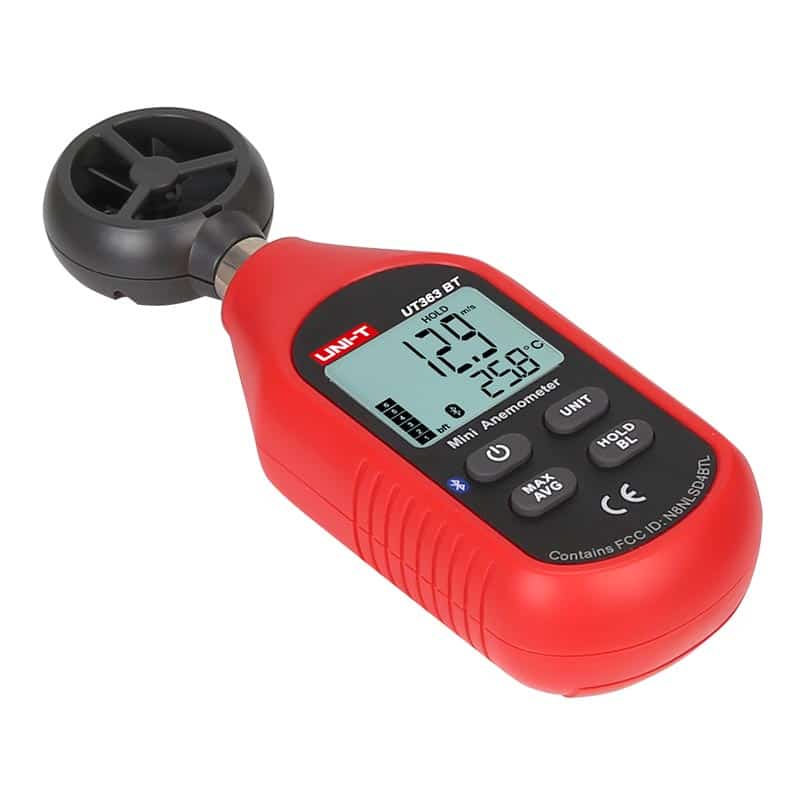Top Functions to Search For in a Reliable Anemometer for Accurate Wind Measurement
Top Functions to Search For in a Reliable Anemometer for Accurate Wind Measurement
Blog Article
All You Required to Know Concerning Anemometers: Just How They Work, Why They Matter, and Where to Utilize Them
Anemometers, though frequently ignored in the realm of clinical instruments, play a vital role in various fields, providing important insights into wind rate and air flow patterns. As we delve right into the complexities of anemometer innovation, we will certainly uncover the inner workings of these devices, their significance, and the key considerations when selecting the best anemometer for details applications.

Anemometer Essentials
A necessary instrument made use of to measure wind rate and direction, the anemometer plays an essential role in weather forecasting and various markets. An anemometer usually includes three or four cups that revolve in the wind, a vane that points right into the wind, and sensing units to track the activities or turnings. By determining the turnings or movements over a certain amount of time, the anemometer can establish wind rate. The vane aids identify wind instructions by pointing right into the wind, offering important data for climate forecasting, air travel, maritime procedures, environmental surveillance, and wind energy applications.
There are various types of anemometers readily available, including mug anemometers, vane anemometers, hot-wire anemometers, and sonic anemometers, each with its one-of-a-kind functions and applications. Mug anemometers are generally made use of for fundamental wind speed measurements, while vane anemometers are preferred for directional dimensions.
Principles of Anemometer Operation
Structure on the fundamental understanding of anemometer essentials, the principles of anemometer operation clarify the technicians behind wind rate and direction dimensions. Cup anemometers, for circumstances, have three or even more cups that record the wind, triggering them to rotate much faster as the wind speed boosts. Hot-wire anemometers rely on a heated wire that cools down as wind passes over it, with the price of cooling establishing the wind rate.
Importance of Anemometers
The value of anemometers in weather forecasting and different sectors can not be overstated. Anemometers play an essential role in gauging wind speed and instructions, giving crucial information for weather forecasting, environment studies, environmental surveillance, and aeronautics operations. Meteorologists rely upon anemometers to collect accurate wind information, helping them comprehend weather condition patterns, anticipate storms, and problem prompt warnings to the public. In markets such as building and construction, farming, renewable resource, and maritime operations, anemometers are made use of to optimize processes, guarantee safety, and boost performance. For instance, wind ranch operators use anemometers to examine wind problems and take full advantage of electrical energy manufacturing from wind generators. In the maritime market, anemometers aid ship navigation by giving real-time wind information to captains, assisting them make informed choices to make certain risk-free trips. In general, anemometers are vital devices that add substantially to security, performance, and notified decision-making in weather forecasting and a variety of sectors.
Applications Across Different Industries
In the renewable energy field, anemometers play a vital duty in examining wind problems for wind ranch positionings, making sure optimal energy manufacturing. Industries like construction and mining use anemometers to monitor wind speeds, check this site out important for safety methods, especially when working at elevations or in open-pit mines where solid winds can pose risks. In farming, anemometers help farmers in handling crop spraying by providing real-time information on wind rate to avoid drift.

Selecting the Right Anemometer for Your Requirements
Choosing the ideal anemometer tailored to your particular needs is essential for acquiring accurate wind rate and direction dimensions. When choosing an anemometer, think about factors such as the designated application, needed measurement variety, environmental conditions, and preferred features. For general purposes, a mug anemometer appropriates for measuring wind speed, while a vane anemometer gives wind instructions information. Hot-wire anemometers are optimal see page for reduced airspeed dimensions, and ultrasonic anemometers provide high precision and durability.

Verdict
In conclusion, anemometers play an important role in measuring wind rate and instructions across different markets. It is essential to think about the importance of anemometers in order to make educated decisions when picking the most appropriate device for determining wind conditions.
There are different types of anemometers readily available, consisting of cup anemometers, vane anemometers, hot-wire anemometers, and sonic anemometers, each with its special functions and applications. Cup anemometers are commonly utilized for fundamental wind rate dimensions, while vane anemometers are chosen for directional measurements. Hot-wire anemometers are appropriate for reduced airspeeds, and sonic anemometers are suitable for high-precision dimensions in research study and industrial settings.Building on the foundational understanding of anemometer basics, the concepts of anemometer procedure elucidate the technicians behind wind speed and instructions measurements. For general purposes, a cup anemometer is suitable for gauging wind speed, while a vane anemometer provides wind instructions information.
Report this page